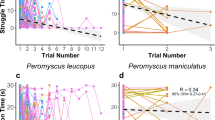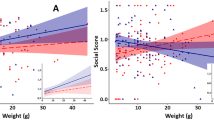Abstract
Behavior varies among individuals and is flexible within individuals. However, studies of behavioral syndromes and animal personality have demonstrated that animals can show consistency in their behavior and as such may be restricted in their behavioral responses. Like any other trait, including morphology, performance, or physiology, personality is now considered an important component of ecology and may have fitness consequences. Moreover, in some species personality correlates with other traits, as predicted in the context of a recent theoretical framework postulating that individual differences in growth and body size can affect behavior through effects on growth–mortality tradeoffs. This “pace of life” hypothesis predicts that animals that explore more should be larger and have higher growth rates than those that explore less. We tested for associations between morphology and a behavioral trait in a captive colony of gray mouse lemurs (Microcebus murinus). We used open-field tests to evaluate exploration behavior and measured a series of morphological traits in 72 individuals (32 males and 40 females). Our results show that the latency to start exploring correlates positively with adult body size and body weight at birth. These data provide evidence for a link between morphology and behavior in this species, thus supporting predictions of dispersal models but diverging from the predictions of the “pace of life” model.

Similar content being viewed by others
References
Albert, F. W., Shchepina, O., Winter, C., Römpler, H., Teupser, D., Palme, R., et al. (2008). Phenotypic differences in behavior, physiology and neurochemistry between rats selected for tameness and for defensive aggression towards humans. Hormones and Behavior, 53, 413–421.
Bartoń, K. (2015). Package ‘MuMIn’: Multi-model inference. R package version 1.15.1.
Benson-Amram, S., Weldele, M. L., & Holekamp, K. E. (2013). A comparison of innovative problem-solving abilities between wild and captive spotted hyaenas, Crocuta crocuta. Animal Behaviour, 85, 349–356.
Biro, P., & Stamps, J. (2008). Are animal personality traits linked to life-history productivity? Trends in Ecology & Evolution, 23, 361–368.
Both, C., Dingemanse, N. J., Drent, P. J., & Tinbergen, J. M. (2005). Pairs of extreme avian personalities have highest reproductive success. Journal of Animal Ecology, 74, 667–674.
Careau, V., & Garland, T. (2012). Performance, personality, and energetics: correlation, causation, and mechanism. Physiological and Biochemical Zoology, 85, 543–571.
Clobert, J., Le Galliard, J. F., Cote, J., Meylan, S., & Massot, M. (2009). Informed dispersal, heterogeneity in animal dispersal syndromes and the dynamics of spatially structured populations. Ecology Letters, 12, 197–209.
Dammhahn, M. (2012). Are personality differences in a small iteroparous mammal maintained by a life-history trade-off? Proceedings of the Royal Society of London B: Biological Sciences, 279, 2645–2651.
Dammhahn, M., & Almeling, L. (2012). Is risk taking during foraging a personality trait? A field test for cross-context consistency in boldness. Animal Behaviour, 84, 1131–1139.
Dammhahn, M., & Kappeler, P. M. (2008). Comparative feeding ecology of sympatric Microcebus berthae and M. murinus. International Journal of Primatology, 29, 1567–1589.
Dingemanse, N. J. (2002). Repeatability and heritability of exploratory behaviour in great tits from the wild. Animal Behaviour, 64, 929–938.
Dingemanse, N. J., Both, C., Drent, P. J., & Tinbergen, J. M. (2004). Fitness consequences of avian personalities in a fluctuating environment. Proceedings of the Royal Society of London B: Biological Sciences, 271, 847–852.
Dingemanse, N. J., & de Goede, P. (2004). The relation between dominance and exploratory behavior is context-dependent in wild great tits. Behavioral Ecology, 15, 1023–1030.
Feenders, G., Klaus, K., & Bateson, M. (2011). Fear and exploration in European starlings (Sturnus vulgaris): a comparison of hand-reared and wild-caught birds. PLoS ONE, 6, e19074.
Freeman, H. D., & Gosling, S. D. (2010). Personality in nonhuman primates: a review and evaluation of past research. American Journal of Primatology, 72, 653–671.
Giroud, S., Blanc, S., & Aujard, F. (2008). Chronic food shortage and seasonal modulations of daily torpor and locomotor activity in the grey mouse lemur (Microcebus murinus). American Journal of Physiology, 294, R1958–R1967.
Guenther, A., & Trillmich, F. (2015). Within-litter differences in personality and physiology relate to size differences among siblings in cavies. Physiology & Behavior, 145, 22–28.
Herborn, K. A., Macleod, R., Miles, W. T. S., Scofild, A. N. B., Alexander, L., & Arnoald, K. E. (2010). Personality in captivity reflects personality in the wild. Animal Behaviour, 79, 835–843.
Jang, K. L., Livesley, W. J., Vernon, P. A., & Jackson, D. N. (1996). Heritability of personality disorder traits: a twin study. Acta Psychiatrica Scandinavica, 94, 438–444.
Kappeler, P. (1991). Patterns of sexual dimorphism in body weight among prosimian primates. Folia Primatologica, 57, 132–146.
Konečná, M., Weiss, A., Lhota, S., & Wallner, B. (2012). Personality in Barbary macaques (Macaca sylvanus): temporal stability and social rank. Journal of Research in Personality, 46, 581–590.
Le Galliard, J.-F., Paquet, M., Cisel, M., & Montes-Poloni, L. (2013). Personality and the pace-of-life syndrome: variation and selection on exploration, metabolism and locomotor performances. Functional Ecology, 27, 136–144.
Nakagawa, S., & Schielzeth, H. (2010). Repeatability for Gaussian and non-Gaussian data: a practical guide for biologists. Biological Reviews of the Cambridge Philosophical Society, 85, 935–956.
Némoz-Bertholet, F., & Aujard, F. (2003). Physical activity and balance performance as a function of age in a prosimian primate (Microcebus murinus). Experimental Gerontology, 38, 407–414.
Pinheiro, J., Bates, D., DebRoy, S., Sarkar, D., & R Core Team (2016). nlme: Linear and nonlinear mixed effects models. R package version 3.1-124.
Pouydebat, E., Gorce, P., Bels, V., & Coppens, Y. (2006). Substrate optimization in nut cracking by capuchin monkeys (Cebus apella). American Journal of Primatology, 68, 1017–1024.
R Core Team (2015). R: A language and environment for statistical computing. R Foundation for Statistical Computing, Vienna, Austria. https://www.R-project.org/.
Réale, D., & Festa-Bianchet, M. (2003). Predator-induced natural selection on temperament in bighorn ewes. Animal Behaviour, 65, 463–470.
Réale, D., Garant, D., Humphries, M. M., Bergeron, P., Careau, V., & Montiglio, P.-O. (2010). Personality and the emergence of the pace-of-life syndrome concept at the population level. Philosophical Transactions of the Royal Society of London B: Biological Sciences, 365, 4051–4063.
Réale, D., Reader, S. M., Sol, D., McDougall, P. T., & Dingemanse, N. J. (2007). Integrating animal temperament within ecology and evolution. Biological Reviews of the Cambridge Philosophical Society, 82, 291–318.
Schliehe-Diecks, S., Eberle, M., & Kappeler, P. M. (2012). Walk the line-dispersal movements of gray mouse lemurs (Microcebus murinus). Behavioral Ecology and Sociobiology, 66, 1175–1185.
Sih, A., Bell, A., & Johnson, J. C. (2004). Behavioral syndromes: an ecological and evolutionary overview. Trends in Ecology & Evolution, 19, 372–378.
Sinn, D. L., Apiolaza, L. A., & Moltschaniwskyj, N. A. (2006). Heritability and fitness-related consequences of squid personality traits. Journal of Evolutionary Biology, 19, 1437–1447.
Stamps, J. A. (2007). Growth-mortality tradeoffs and “personality traits” in animals. Ecology Letters, 10, 355–363.
Stamps, J., & Groothuis, T. G. G. (2010). The development of animal personality: relevance, concepts and perspectives. Biological Reviews, 85, 301–325.
Terrien, J., Zizzari, P., Bluet-Pajot, M.-T., Henry, P.-Y., Perret, M., Epelbaum, J., & Aujard, F. (2008). Effects of age on thermoregulatory responses during cold exposure in a nonhuman primate, Microcebus murinus. American Journal of Physiology, 295, 696–703.
Thomas, P., Pouydebat, E., Hardy, I., Aujard, F., & Herrel, A. (2015). Sexual dimorphism in bite force in the grey mouse lemur. Journal of Zoology, 296, 133–138.
Thomas, P., Pouydebat, E., Le Brazidec, M., Aujard, F., & Herrel, A. (2016). Determinants of pull strength in captive grey mouse lemurs. Journal of Zoology, 298, 77–81.
Videlier, M., Bonneaud, C., Cornette, R., & Herrel, A. (2014). Exploration syndromes in the frog Xenopus (Silurana) tropicalis: correlations with morphology and performance? Journal of Zoology, 294, 206–213.
Videlier, M., Cornette, R., Bonneaud, C., & Herrel, A. (2015). Sexual differences in exploration behavior in Xenopus tropicalis? Journal of Experimental Biology, 218, 1733–1739.
Vuarin, P., Dammhahn, M., & Henry, P.-Y. (2013). Individual flexibility in energy saving: body size and condition constrain torpor use. Functional Ecology, 27, 793–799.
Weiss, A., King, J., & Figueredo, A. (2000). The heritability of personality factors in chimpanzees (Pan troglodytes). Behavior Genetics, 30, 213–221.
Wilson, V., Lefevre, C. E., Morton, F. B., Brosnan, S. F., Paukner, A., & Bates, T. C. (2014). Personality and facial morphology: links to assertiveness and neuroticism in capuchins (Cebus apella). Personality and Individual Differences, 58, 89–94.
Wolf, M., & Weissing, F. J. (2010). An explanatory framework for adaptive personality differences. Philosophical Transactions of the Royal Society of London B: Biological Sciences, 365, 3959–3968.
Wright, C. M., Keiser, C. N., & Pruitt, J. N. (2015). Personality and morphology shape task participation, collective foraging and escape behaviour in the social spider Stegodyphus dumicola. Animal Behaviour, 105, 47–54.
Acknowledgments
We thank Éric Gueton-Estrade, Sandrine Gondor-Bazin, and Lauriane Dezaire for their help with the care of the animals; Fathia Djelti for her help with the open-field software; and Pierre-Yves Henry and Manon Ghislain for their advice on statistical analysis. The editor and two anonymous reviewers are also acknowledged for their helpful and constructive comments that helped improve this paper.
Author information
Authors and Affiliations
Corresponding author
Electronic supplementary material
Below is the link to the electronic supplementary material.
Table SI
(DOCX 17 kb)
Rights and permissions
About this article
Cite this article
Thomas, P., Herrel, A., Hardy, I. et al. Exploration Behavior and Morphology are Correlated in Captive Gray Mouse Lemurs (Microcebus murinus). Int J Primatol 37, 405–415 (2016). https://doi.org/10.1007/s10764-016-9908-y
Received:
Accepted:
Published:
Issue Date:
DOI: https://doi.org/10.1007/s10764-016-9908-y




